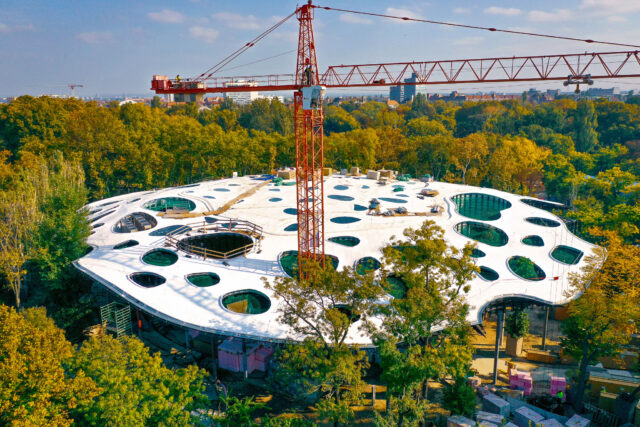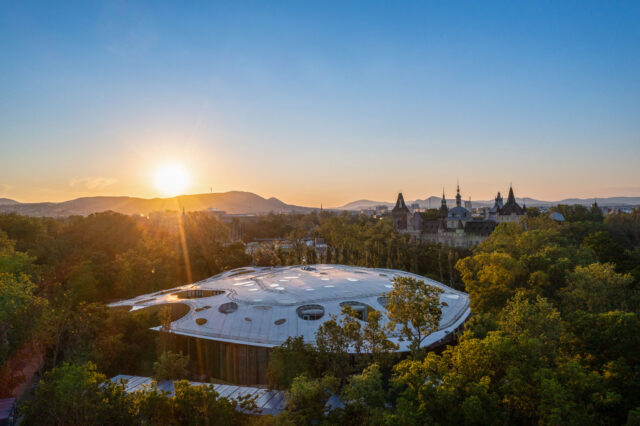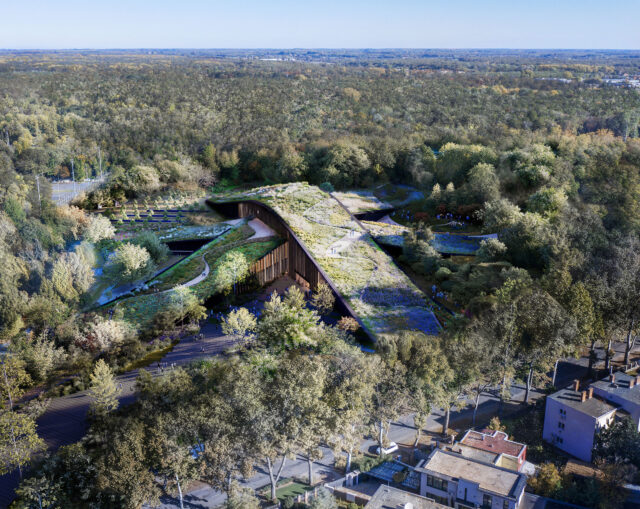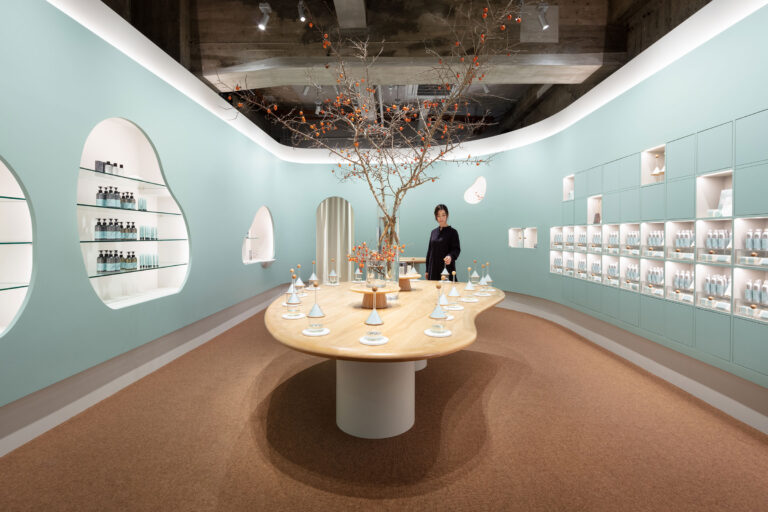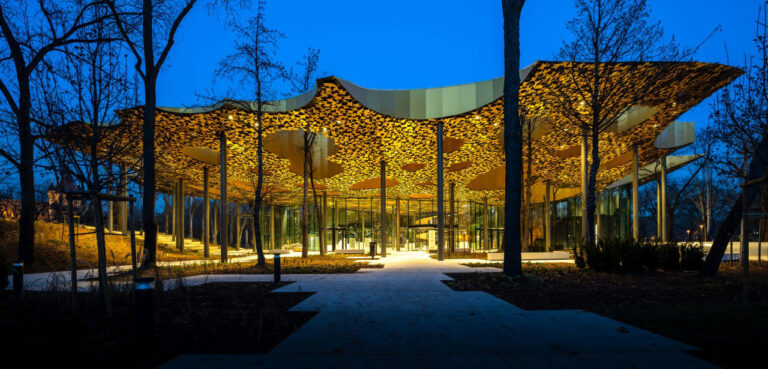
SHARE 藤本壮介による、ハンガリー・ブダペストの「ハンガリー音楽の家」が完成。国内最大規模の公園を敷地として建設、自然と建築の環境の境界をなくす事を意図し、音の振動を視覚的に表現した“波”から着想を得て設計された施設




藤本壮介による、ハンガリー・ブダペストの「ハンガリー音楽の家」が完成。国内最大規模の公園を敷地として建設、自然と建築の環境の境界をなくす事を意図し、音の振動を視覚的に表現した“波”から着想を得て設計された施設となっています。アーキテクチャーフォトでは2021年1月に建設段階の様子も特集記事として紹介していました。施設の公式サイトはこちら。
こちらはリリーステキストの翻訳です
「リジェ・ブダペスト・プロジェクト(The Liget Budapest Project)」は、ハンガリー最大規模の公園・景観整備と、ミレニアム時代以来の規模の施設開発を組み合わせた、現在ヨーロッパで最も重要な文化開発です。リジェ・ブダペスト・プロジェクトを構成する「ハンガリー音楽の家(The House of Hungarian Music)」は、ブダペスト最大の見どころである英雄広場の近くに、取り壊されたかつてのオフィス街の跡地に建設されています。設計者の藤本壮介は、ユニークで刺激的、かつ有機的な建物を創り上げました。彼のデザインは、国際コンペに提出された168のプロジェクトの中から、ハンガリーおよび国際的な審査員によって選ばれたものです。
藤本壮介のヴィジョン
藤本は「ハンガリー音楽の家」の国際コンペに応募する際、自然環境と建築環境の境界をなくし、自然の音と音の自然の調和を図るプロジェクトを思い描きました。デザインの特徴である浮き屋根は、音の振動を視覚的に表現した「波」から着想を得ています。藤本は、開放性と透明性の精神に基づき、建物の側壁をガラス張りにし、光井で連結された屋根のパンチング構造から、木の葉のように光を建物内部に取り込むように設計しました。また、ブダペストのリスト音楽院の有名な分離派の建物や、国際的に有名なハンガリーの音楽と音楽教育の伝統からもインスピレーションを受けたといいます。
藤本壮介は自身のビジョンをこう語ります。
「世界初の公共公園のひとつで仕事をするというのは、信じられないほど刺激的なことです。リジェ・ブダペスト・プロジェクト、そしてその中の『ハンガリー音楽の家』は、まさに象徴的な開発プロジェクトであり、緑と建築物の調和を実現したことから、将来の都市開発者の手本になるかもしれません。」
ユニークな建築的解決策
藤本のヴィジョンを実現するための特徴のひとつが、建物の壁面をガラス張りにしたことで、優雅さ、透明感、個性を演出しています。「ハンガリー音楽の家」のユニークな外観は、特別な技術的ソリューションと結びついています。ファサードのガラス壁は94枚の特注の断熱パネルで構成され、建物の一部では高さが12m近くにもなっているのです。
もうひとつの象徴的なデザインは、有機的な屋根の構造です。藤本が音波の形から着想した特殊な浮き屋根です。厚みの異なるキャノピーが戯れるようにうねり、葉の高さよりも低い位置にあることで、建物が環境と調和していることを保証しています。
藤本壮介は語ります。
「『ハンガリー音楽の家』の壮大で明白な姿を支えているのは、ハンガリーで前例のないデザインとエンジニアリングのソリューションの数々です。屋根の構造には直角がなく、同じものは2つとありません。さらに、この開口部には革新的なソリューションが導入されています。光井はここから始まり、光を最下部まで導き、室内を明るく照らし、独特の雰囲気を作り出すのに役立っています。」
環境への配慮と持続可能性
「ハンガリー音楽の家」の建設にあたっては、環境への配慮が最も重要視されました。特に、再生可能エネルギーと特殊な冷暖房システムの使用は、プロジェクトの計画段階から重視されました。再生可能な地熱エネルギーを供給するために、120台のヒートポンプが、建物に隣接するナギーレトと呼ばれる都市公園の小さなエリアの地下100メートルに設置されました。もう一つの経済的で極めて革新的なソリューションが、テレクーリングシステムです。「ハンガリー音楽の家」の建物とその建設は、世界的な持続可能性評価手法であるBREEAMによって、環境の観点から模範的であると評価されました。
建築と音楽の両分野から評価される
「ハンガリー音楽の家」の注目すべき建物は、国際的な建築界の注目を集めました。2019年、ロンドンで開催された権威ある国際不動産賞のコンペティションで、ヨーロッパで最も優れた公共サービス建築プロジェクトに選ばれました。これは、27年前に始まった不動産分野における最大規模の、最も権威のある、広く称賛される評価の1つです。そして2020年、音楽を媒介として都市の経済的、社会的、文化的発展を促進することを目的に、音楽業界の最も重要な国際的プレーヤーが主催する著名なイベントシリーズ「American Music Cities Awards」の「Best Use Of Music In Property Development/Real Estate」部門で、音楽をテーマにした世界最高の開発として賞を受賞したのです。音楽における優れた取り組みが9つのカテゴリーで評価されました。「ハンガリー音楽の家」は、10人の国際的な専門家からなる審査員によって、唯一のヨーロッパのプロジェクトとしてトップ3に選ばれ、米国の2つの開発プロジェクトを抑えて本賞を受賞しました。
「ハンガリー音楽の家」の内容
「ハンガリー音楽の家」のユニークな外観と、それに見合った特別な内部構造。地下1階には常設展と企画展、そしてサウンドドームが設置され、公園階は舞台芸術のための施設となっています。その上の階にはハンガリーのポップミュージックのアーカイブがあり、音楽と教育に静かに浸ることができます。また、音楽教育室で行われるワークショップは、若い訪問者に展示やパフォーマンスで待ち受けている複雑な音楽体験に入るきっかけとなります。
「ハンガリー音楽の家」は、21世紀のテクノロジーを駆使したインタラクティブな展示、音楽教育ワークショップ、音楽イベント、音楽をテーマにしたイベント、そしてかつての音楽パビリオンの雰囲気を再現した野外コンサートによって、この豊かな音楽の伝統を国内外の訪問者に身近なものにすることでしょう。ハンガリーの芸術の中で、おそらく最もよく知られ、世界で最も認められている分野である音楽を、一般の人々に紹介することを使命とする、待望の新しい施設が都市公園に設立されます。
以下の写真はクリックで拡大します

































竣工後の様子を紹介する動画
藤本壮介によるプロジェクトの解説を収録している動画
以下、リリーステキストです。
The Liget Budapest Project is currently Europe’s most significant cultural development, which combines Hungary’s largest-scale park and landscape architecture project with the development of institutions not seen on a scale since the days of the millennium. The House of Hungarian Music, a development forming part of the Liget Budapest Project is being constructed near Heroes’ Square, one of Budapest’s most important attractions, on the site of a formerly demolished office block. The designer, Sou Fujimoto, has created a unique, inspiring and organic building. His design was selected by Hungarian and international jurors from among 168 projects submitted to an international competition.
Sou Fujimoto’s vision
When entering the international competition for the House of Hungarian Music, Fujimoto envisioned a project in which the boundary between the natural and the built environments is dissolved, and harmony is struck between the nature of sound and the sounds of nature. The signature feature of the design, the floating roof, was inspired by the visual representation of the vibration of sound: the wave. In the spirit of openness and transparency, Fujimoto designed the side walls of the building to be made of glass and the perforated structure of the roof articulated by lightwells to let light into the interior of the building much like the foliage of trees. He also drew inspiration from the famed Secessionist building of the Liszt Academy in Budapest and, not least, by the internationally renowned tradition of Hungarian music and music education.
“It is incredibly inspiring to work in one of the world’s first public parks, and the task of designing the building was especially exciting since we not only created an edifice but also brought the park experience into the building. The Liget Budapest Project, and within it the House of Hungarian Music, are a truly emblematic development project, which might serve as an example for future urban developers since it managed to create exceptional harmony between the green and the built-up environments.” – noted Sou Fujimoto about his vision.
Unique architectural solutions
One of the features facilitating the implementation of Fujimoto’s vision is the building’s glass wall, which lends it gracefulness, transparency and individuality. The unique appearance of the House of Hungarian Music is coupled with special engineering solutions: the glass wall of the facade consists of 94 custom-manufactured heat-insulated panels, which are close to 12 metres high in some parts of the building.
Another iconic feature of the design is its organic roof structure: Fujimoto’s special floating roof was inspired by the form of soundwaves. The playfully undulating canopy of varying thickness stays below the level of the foliage, ensuring that the building harmoniously blends in with the environment.
“Underpinning the spectacular and unmistakable sight of the House of Hungarian Music is a host of design and engineering solutions unprecedented in Hungary. There are no right angles in the roof structure, almost no two elements that are the same. It is all unique and the surface is punctured by close to 100 individually designed holes for the trees of the park to emerge through; moreover, one of the innovative solutions was also installed in these openings: the lightwells begin here, which channel the light right down to the lowest levels, thus helping to illuminate the interiors and create a unique ambiance.” – said Sou Fujimoto.
Environmental awareness and sustainability
Environmental awareness has been of paramount importance throughout the construction of the House of Hungarian Music. Special emphasis was accorded to renewable energy and the use of special heating and cooling systems already in the planning phase of the project. One hundred and twenty heat pumps were installed 100 metres underground in a small area of the City Park, called Nagyrét, next to the building to provide renewable geothermic energy. Another economical and extraordinarily innovative solution is the telecooling system. The building of the House of Hungarian Music as well as its construction were rated as exemplary from an environmental perspective by BREEAM, the world’s leading international sustainability assessment method.
Recognition from both the architectural and the music profession
The remarkable building of the House of Hungarian Music drew the attention of the international architectural community. In 2019 it was selected as the best public service architecture project in Europe at the prestigious International Property Awards competition in London, one of the largest-scale, most prestigious and widely acclaimed recognitions of the property sector launched 27 years ago. Then, in 2020, it won the award for the world’s best development with a musical theme in the “Best Use Of Music In Property Development/Real Estate” category at the American Music Cities Awards, a prominent series of events organised by the most important international players in the music industry with the aim of fostering the economic, social and cultural development of cities through the medium of music. The best initiatives in music were evaluated in nine categories. The House of Hungarian Music was chosen among the top three by a jury of ten international experts as the only European project and won the main prize beating two US developments.
The content of the House of Hungarian Music
The unique appearance of the House of Hungarian Music is matched by a special interior structure. The institution’s complex musical profile and programmes are reflected by the three-level layout: the level below ground will be home to exhibitions – permanent and temporary – and a remarkable sound dome; the park level is devoted to the performing arts: live events will be held in the concert halls and the open-air stage alike, while the terrace near the City Park Lake will be a place for recreation; while the level above it will house an archive of Hungarian pop music, serving as a source of quiet immersion in music and education, and the workshops to be held in the music education rooms will initiate young visitors into the complex musical experience awaiting them at the exhibitions and performances.
The House of Hungarian Music will take this rich musical tradition closer to domestic and foreign visitors with its interactive exhibitions utilising 21st-century technology, music education workshops, musical events and those themed on music as well as with its open-air concerts evoking the atmosphere of the musical pavilions of the past. A new, long-awaited institution will be established in the City Park, whose mission is to take music – perhaps the branch of Hungarian art that is best known and most recognized in the world – to the general public.

